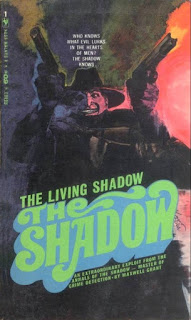The origins of the Shadow are an
interesting, and appropriately twisting gyre of early cross-media
promotion.
Once upon a time, Street & Smith
published a pulp mag called Detective Story Magazine.
On July 31, 1930, Detective Story Hour
premiered on the radio for adaptations of stories from the magazine,
and to shill other Street & Smith publications. The narrator of
the show was a mysterious voice known only as The Shadow (a clever
piece of marketing itself).
It
worked, but not exactly as expected. The Shadow's sinister charisma
had audiences going to the stands to buy magazines, but they weren't
asking for Detective Story.
They wanted The Shadow. Which didn't exist.
Street
& Smith were smart enough to see a demand hungry for a supply,
and hired up-and-coming mystery writer (and former reporter, stage
magic afficionado, and crossword puzzle writer) Walter B. Gibson, to
create a character whole cloth out of nothing more than a voice.
Under
the pseudonym Maxwell Grant, Gibson would go on to write 300 Shadow
novels, so it worked out pretty well.
Shadow Magazine
Volume 1, issue 1 appeared on stands in April of 1931, featuring The
Living Shadow, Gibson's first
published Shadow story.
What
follows is pulp as hell.
We
meet suicidally depressed Harry Vincent on a bridge in New York. He
got a letter from his old girlfriend back in Michigan dumping him,
and so like a bitch, he jumps.
Fate
intervenes in the form of the Shadow, who yanks him back onto the
bridge and offers him a deal: Harry's financial woes are forever
taken care of, but he has to obey any and every command of the
Shadow's. Or they could go back to the bridge and Harry goes over the railing again. Harry's life belongs to the Shadow now, and decides his old life is dead anyway, so he eagerly agrees to become an Agent..
It
doesn't take long. Harry is introduced to another Shadow Agent, intermediary Claude Fellows. Harry is sent into a nearly fatal
disastrous investigation of a fence operating out of a tea shop in
Chinatown. Re-shuffled to a murder investigation in Long Island
that's got the police stumped.
Mystery!
Investigations! Misdirection! Disguises! Murder! Car Chases!
Fistfights! Deathtraps! Crossword Puzzles! About the only thing it
doesn't have is estrogen. Margo Lane wouldn't appear in radio until
1937 and in the pulps until 1941.
Anything
else would give away the plot, and it takes some very clever turns.
What's
more important is that it establishes the Shadow as a character: He
has a mysterious drive to punish evil-doers and is fabulously
wealthy. He says that he can spend the lives of his agents if he
wants to, but goes to great lengths to help and protect them in
danger. He is a master of disguise beyond normal physical
limitations. He can travel convincingly through shadows and its never
made clear if its supernatural or not. He has his trademark laugh.
These last bits move the story from a master detective with enough
prep-time hax to make Batman blush (makes sense, since Batman's the
bastard son of the Shadow) into supernatural fantasy.
What's
even more amusing is that at one point, Harry Vincent is instructed
to tune into the radio at a specific time and channel to hear his
next orders from the Shadow. It is a blatant nod to the the Shadow's
real-life radio presence and a brilliant piece of cross-media
marketing.
Imagine
being a loyal listener of the show and finally reading the Shadow's
print stories only for it imply that at any time, you, yes YOU, could
hear instructions from the Shadow to help him in his crusade on
crime. Really tickles the tympanic membrane, doesn't it?
As an
introduction, The Living Shadow
succeeds, such that Street & Smith would publish it again in
hardcover the next year and there would be numerous reprints over the years. Its not the Shadow and his mythos fully
developed, hell, the Shadow's identity as Lamont Cranston or Kent
Allard isn't even established yet. Yet there's enough there to be
unmistakably The Shadow, and its fun as hell.
Highly recommended.




No comments:
Post a Comment